Survey: “Citizen participation in the use of algorithms by the municipality of Amsterdam”
Onderdeel van
Trefwoorden
An overview and analysis of a survey conducted in 2023 to investigate citizen's perspectives, needs, and challenges when it comes to providing input on the municipality's use of algorithms
As part of a collaborative research project with Digital Rights House, the Research and Statistics department of Gemeente Amsterdam administered an online survey on May 2023 titled “Citizen participation in the use of algorithms by the municipality of Amsterdam”. The survey focused on if and how citizens would like to learn more and participate on the topic of algorithms in the municipality.
Goals
The thought behind conducting a survey was to use online channels to reach a wider audience than the other participation methods, through a format which takes relatively little time. This method included an explanation of algorithms and examples of those used by the municipality, before diving into deeper questions about the if/ when/ how of citizen’s desire to participate on the topic of municipal use of algorithms.
Description
A 15-question survey was developed specifically on the topic of citizen participation and municipal use of algorithms. It was distributed online for a period of two weeks to 200 randomly selected participants from an existing panel managed by the Office of Research and Statistics. Of the 200, 99 participants completed the survey.
The survey is divided into 5 sections. The first section aims to evaluate the participant’s awareness of algorithms and their use within the municipality. The second section provides definitions of algorithms, alongside three examples of algorithms used by the municipality. The examples are purposely chosen to represent the diverse use-cases for algorithms in municipal governance. This is followed by questions gauging the participants' sentiments about the use of algorithmic decision making by the municipality, as well as their desire and ability to participate on this topic as citizens. The third section dives deeper into how citizens would like to provide input on the municipality’s use of algorithms, both in terms of participation channel and in terms of phase in the algorithm lifecycle. The fourth section introduces the idea of the algorithm register, followed by questions to gauge the participant’s knowledge of and interest in using the tool. Finally, the last section is meant to give participants an opportunity to provide feedback on the survey as a whole, and to leave any additional comments.
Building the survey
Developing the survey was an iterative process, with multiple rounds of feedback from both Digital Rights House and the Research and Statistics department of the Municipality of Amsterdam. The following were the key themes of the feedback.
Firstly, the purpose of the survey should be introduced from the start. In terms of structure, it should be relatively short and digestible, and participants should have the opportunity to opt out of a question or to elaborate on a response. Additionally, it is crucial to provide definitions and examples. Because we assume that most citizens have limited knowledge of algorithms and their use by the municipality, definitions and examples help level the playing field and provide a good starting-off point to anchor their answers in something real and specific. These explanations should not use technical terms that may not be understood by all participants. Similarly, when asking about participation in different phases of the algorithm lifecycle, citizens might not understand what these phases are and what they entail. It is important to explain, for example, what happens in the algorithm design phase and how citizens could participate.
Findings
The start of the survey focuses on citizen awareness about algorithms and their use by the municipality.
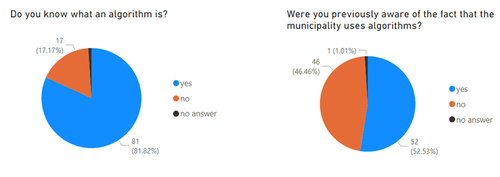
As such, 82% of participants say that they know what an algorithm is, while only 52% say that they were previously aware that the municipality uses algorithms. This shows a significant gap in awareness that presents a fundamental obstacle to citizen participation on the topic. It also aligns with comments from other participation efforts which indicate that citizens have a very limited perception of what algorithms can be used for, but also of the municipality’s functions more broadly.
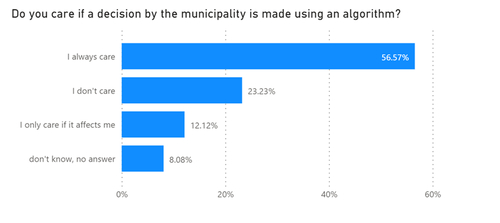
Participants were then asked if they care if a decision by the municipality is made using an algorithm. More than half (57%) said yes, which supports the idea that citizens should be informed when an algorithm is in use, especially when it is used to make a decision that affects them.
Respondents were then given the opportunity to elaborate on their responses. Their comments have been grouped below.
Concerns about the use of algorithms
Respondents had several recurring concerns about the potential harms of using algorithms. Prominent among them was concern about prejudice and bias, specifically in the “characteristics, parameters, and predetermined goals embedded into the algorithms”. This bias is linked to profiling people or dividing them into groups, leading to disparate treatment and unjustified intervention, as seen in the childcare benefits scandal (toeslagenaffaire). The scandal is referenced multiple times as a reason for decreased confidence in algorithms and in the government.
In general, respondents questioned whether the use of algorithms in public services is ethical and desirable. This relates to the perception that algorithms are limited and lack “empathy and human thinking”, along with nuance and context. Blind trust in computers and algorithms, with no regard for errors or exceptions, is seen as dangerous; “when no appeal or human intervention is possible, it becomes scary,” wrote one respondent. There is a common fear of generalization when “every situation is different”, and “citizens are people not protocols”. Some even linked the use of algorithms to oversimplified policy. There is also discomfort at the idea of humans being replaced by systems: “the world is cold enough without this approach”.
Beyond linking the use of algorithms to a lack of empathy, some respondents felt that algorithms are a way for the government to control citizens “from above”. “Algorithms can lead to a tyrannical dictatorship”, one respondent argued. This sentiment was also linked to concerns about privacy and the use of data. As such, respondents argued that there must be checks in place and legal limits to the use of algorithms. Furthermore, algorithms and the assumptions embedded into them should be open for public scrutiny; “I want to know how I and my fellow Amsterdammers are observed and analyzed.”
Acceptance of algorithms
However, not all respondents shared the same perspective on the use of algorithms. Many expressed an accepting attitude towards the use of algorithms, although it was typically nuanced or conditional. They saw algorithms as convenient and even necessary in some cases. One participant wrote that “using this technology makes many processes much more efficient. I like the idea of knowing that the government and municipalities keep up with the times.” Another described algorithms as “specific and precise”, and a way to overcome administrative bottlenecks. Yet another emphasized that algorithms follow the same assessment and decision-making steps as humans. Some were more measured with their responses, expressing that algorithms can be beneficial in most situations, but not all. Another consideration was whether the algorithm was sufficiently checked, and if and how citizens could appeal decisions. “I am not against algorithms”, one wrote, “but I am against them if they become an extra bureaucratic hurdle for citizens.”
Transparency and awareness
“The use of algorithms is unavoidable and also of social importance, but the use must be transparent and adequately documented,” wrote one respondent, highlighting the importance of transparency efforts by the municipality. They continued to say that some level of accountability exists when a human makes a decision, in that they can be asked to explain their reasoning. However, with algorithms, decision-making becomes a black box. To that point, several respondents asked questions about how algorithms work and how they may impact a decision-making process, highlighting the need for awareness and education about algorithms in order to achieve transparency.
The next two questions were about desire and perceived ability to give input on the use of algorithms by the municipality.
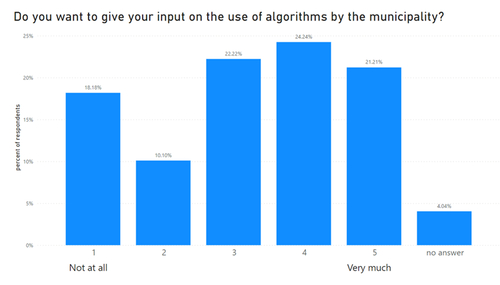
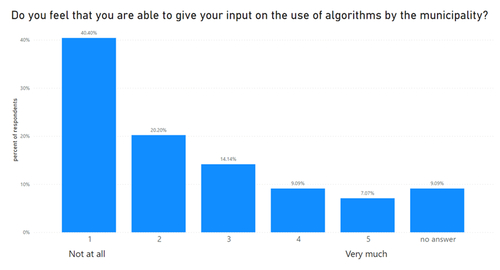
68% of respondents were at least somewhat interested in giving input on the use of algorithms by the municipality, with 21% being very interested; only 18% said that they were not interested at all. However, 40% of respondents said that they did not at all feel able to give their input on the use of algorithms by the municipality. This highlights the importance of removing barriers to participation and creating awareness of opportunities to provide input.
Respondents were given the opportunity to elaborate on their answers. Many of them were interested in participating but either didn’t know how to participate or didn’t feel they knew enough about the topic. Others were pessimistic about the lack of impact- they essentially felt that their contribution would be useless. The comments have been grouped into a few common statements below.
I have never looked for opportunities to give input, but I would like to.
These respondents are interested or have an opinion on the topic, but don’t know how to participate. One wrote the following: “I want to remain involved in decision-making about the neighborhood where I live, and about Amsterdam”. Another said that “input from residents about its use is, I think, desirable; not about you and without you, but with you!”
I would not be able to make an impact. Nothing can change now.
A couple of respondents felt that citizens have no influence on the use of algorithms by the municipality. In particular, they felt that once an algorithm has been adopted, nothing can be done. This is because they believe that algorithms are built on behalf of the municipality, which makes them beyond the control of citizens.
I am not sure what participation entails.
“I have no idea what kind of input the municipality expects,” said one of the respondents. Others wondered how their contributions would be used, and even if their information would be incorporated into an algorithm.
I know nothing about algorithms and/or about what the municipality is doing in this area.
Respondents feel that algorithms are difficult to understand, and some even stated that they don’t want to make the effort to understand them. Because they are not experts, they feel that they may not be able to give well-substantiated input. They also wouldn’t know where to start or who to go to; one asked whether there is someone “handling” algorithms. Transparency is also a key concern- “I have no insight into the use of this in the various departments of a municipality, so I cannot give an opinion on this,” one respondent wrote.
The municipality has not asked me to participate.
One respondent asserted that no one is currently commenting or participating on the topic of algorithms. “So far, the municipality has not asked citizens anything, perhaps until now,” another added.
I am not interested, or I am not sure how this is relevant to me.
Some respondents simply did not want to participate on this topic or were not sure why they should. Others specified that the responsibility of dealing with issues of algorithmic governance should not fall upon citizens: “this is a task of the municipal council within legal frameworks… I would not want individual citizens to participate in decisions about whether or not to use algorithms.”
The following series of questions aims to understand in what phase(s) of the algorithm lifecycle citizens are interested in participating, and illustrating to respondents the different forms that participation could take.
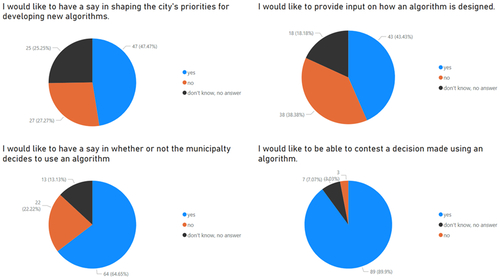
Overall, it appears that citizens feel the most strongly about participation in the later phases of the algorithm lifecycle. Specifically, 90% said that they would like to be able to contest a decision made using an algorithm (only 3% said no). 64% said they would like to have a say in whether the municipality decides to use an algorithm.
Still, a significant number of respondents expressed interest in shaping the city’s priorities for developing new algorithms and providing input into how algorithms are designed (47% and 43% respectively). What is interesting about these questions is the number of respondents who said don’t know/ no answer. This likely indicates a lack of understanding of what happens in these early phases of the algorithm lifecycle, and what citizen participation could entail.
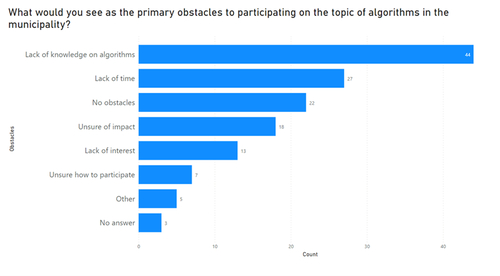
Respondents identified the lack of knowledge about algorithms and their use as their primary obstacle to participation. This highlights the importance of the register and other transparency initiatives in increasing awareness, and as a result, enabling participation.
Those who answered “other” were given the chance to explain what they perceive as obstacles to participation. Here, several mentioned the role of the municipal council. One mentioned that they preferred not to participate personally, but would rather leave the decision to experts and elected representatives. In contrast, another expressed that they had “wasted a lot of time” trying to give input through the council, but that nothing was ever done, and they were often “not even listened to”. Similarly, one respondent added that there is no space for respondents to share their opinion to the municipality.
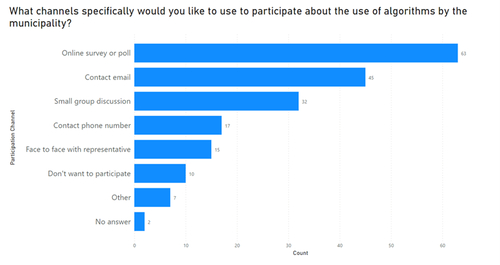
In terms of how they would like to participate, most respondents preferred online channels, especially online surveys or polls. However, this result is probably biased by the fact that the respondents are already used to taking online surveys. Of the in-person options, small group discussions were the most popular, with 32% of respondents expressing interest. In the “other” box, participants were interested in participating through elected council members and appointed officials such as the ombudsman, or through more permanent bodies such as a committee or council. They also expressed interest in educational events such as conferences.
The focus of the survey then shifts to the algorithm register.

94% of respondents had never heard of the algorithm register. When asked if they would use the tool, 39% said yes, while 45% said they were not sure. Respondents were then asked to clarify. Overall, many still didn’t understand what the register is and what it contains. However, some highlighted its potential importance as a source of information to enable them to better participate.
Respondents expressed confusion about the existence of the register and what it contains: “I now have no insight into what this register presents to me”. Despite the short explanation provided in the survey, they still found it difficult to understand. Others expressed that they could use it, but they didn’t know when or for what. One specified that they would find the register useful if it explains “the algorithm does and how it arrives at its advice and how it is checked”.
While some respondents directly said that they would not use the register because it is too complicated and lacks a concrete impact, others were more interested. They said that it seems useful as a source of information and would allow them to better participate and “exert influence”. “I do want to know which algorithms are used in the system and also the motivation behind it,” emphasized one respondent.
A few responses also reiterated the need for citizens to know whether a decision has been made using an algorithm, so that they may then participate. “If I would like to challenge a decision, I first want to know whether the decision was made on the basis of an algorithm,” said one respondent, while another stated that the register would only be useful to them if they already knew that a decision was made using an algorithm.
Because this survey is exploratory and meant to shape future research, respondents were invited to give feedback on the survey itself.
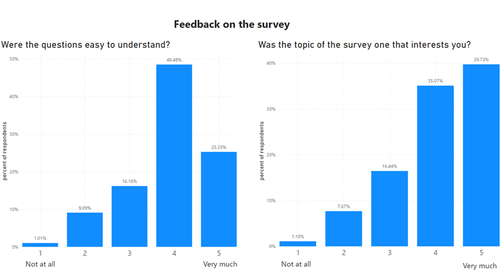
The most common feedback was on the clarity of the topic and making things easier to understand/ providing more examples. At the same time, 74% rated the ease of understanding questions as a 4 or 5 out of 5.
Similarly, 75% answered 4 or 5 when asked if they are interested in the topic of this survey. This is encouraging with regard to citizen interest in participating on this topic. It must be taken into account that this is already a self-selecting group who already responded to the whole survey.
Respondents were also given a final opportunity for feedback, from which the following themes emerged:
The survey could be more clear.
Some respondents commented that the explanations provided in the survey were not understandable for everyone, specifically regarding the purpose and deployment of algorithms. “I saw opportunities to explain it more clearly,” said one, while another suggested providing more examples.
“I would have found figures on this subject useful; for example, how many objections have been declared well-founded after cases that have been established using algorithms (think of parking fines, etc.)”
Overall, the topic was found by many to be “difficult and laborious”, and remains vague despite the information provided on the survey.
The framing of the survey is biased
“ I think this is a weird survey that seems very biased to me. Working with algorithms is made suspicious, while you wouldn't ask me to assess an employee's working method.” This respondent felt that the survey was too critical of algorithms, and implied that algorithms should be treated in the same way as human decision-making.
The survey is a step in the right direction.
“Understanding what can be done with algorithms and AI and how it works is of great importance,” shared one respondent. They felt that efforts such as this survey could help to prevent misinformation about the use of algorithms.
A follow-up to the survey is required.
A few respondents had follow-up questions after the end of the survey, expressing an interest in learning more about the municipality’s use of algorithms. One highlighted the need for “feedback and follow-up plans”.
Conclusion
To begin with, there seems to be a gap in awareness among respondents about the municipality’s use of algorithms, which presents a fundamental obstacle to citizen participation on the issue. Furthermore, citizens do care if a decision by the municipality is made using an algorithm and would want to be informed when the decision is made. This is due to concerns about the use of algorithms leading to prejudice, bias, and lack of empathy. Lack of visibility into the municipality’s use of algorithms is also a source of concern.
Furthermore, most participants are at least somewhat interested in giving input on the municipality’s use of algorithms, but feel that they are not currently able to. Although there is significant interest in participating at every step of the algorithm lifecycle, respondents feel the most strongly about being able decide whether or not the municipality uses an algorithm, and being able to contest a decision made by an algorithm. Lack of knowledge on algorithms and their use is seen as the primary obstacle for citizen participation. This underlines the importance of efforts to increase citizen awareness on the topic, and to ensure that transparency tools such as the register are more widely accessible. In fact, almost none of the respondents were aware of the existence of the register, and many were unsure of how it would be useful to them. This presents an opportunity to increase awareness of the register once the new version is published, and to show citizens how this tool can best serve their needs.
Respondents prefer to participate through online channels such as surveys, but this result is not necessarily generalizable to the wider public. Most of them also expressed that the topic of this particular survey was of interest, and some even mentioned that it was the first time they have been able to give their input on the use of algorithms by the municipality.